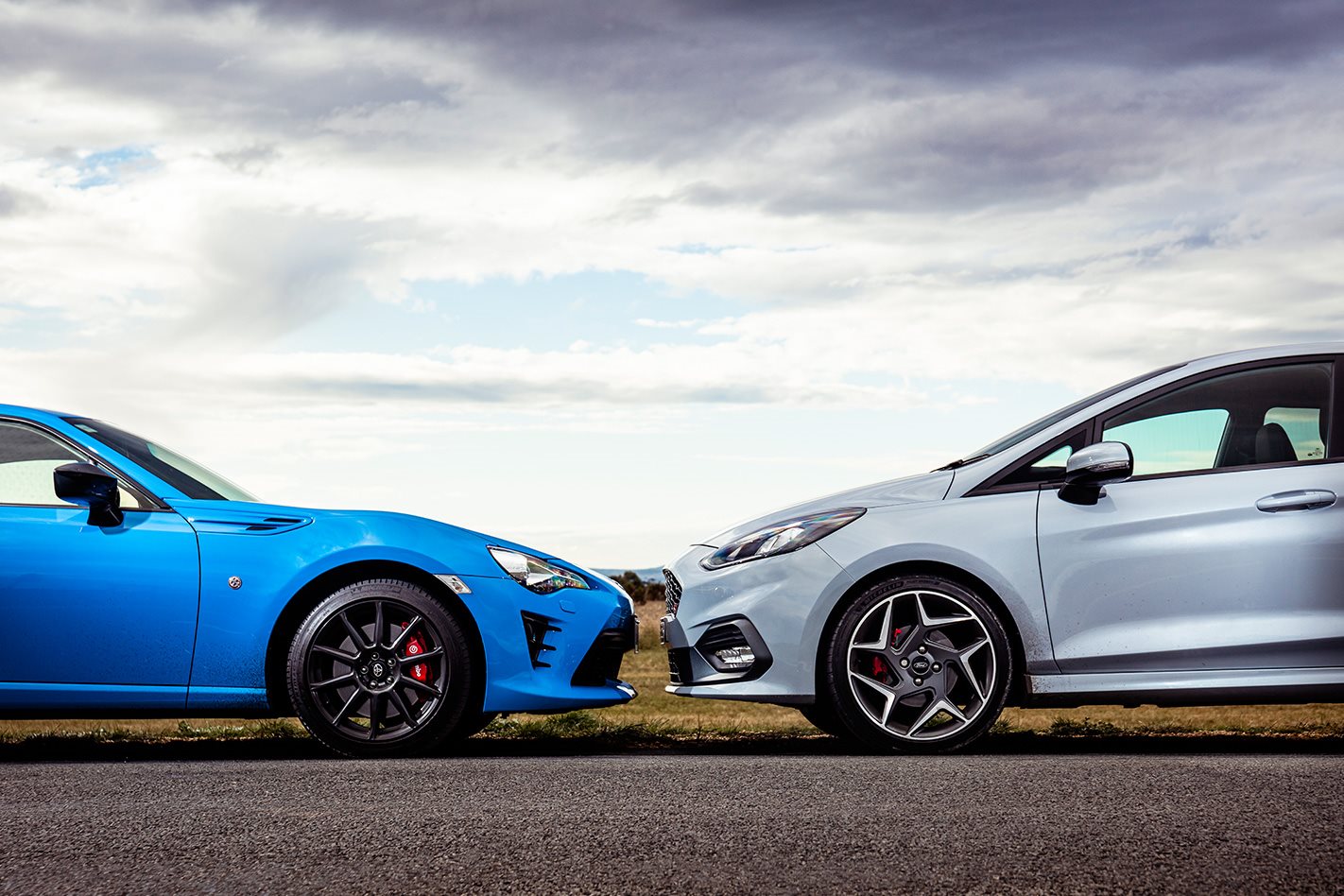WHEELSPIN! THE TOYOTA 86 GTS demands opposite steering lock as its chassis tweaks a few degrees. Its rear tyres flick loose gravel out behind us as they scrabble for grip. But you mash the throttle, not needing to worry as there’s only 147kW to wrestle with, and feel the track-tuned ESP meter out the exact amount of Newtons needed. As the rear boots bite it begins another ascent to its heady 7400rpm redline, dipping into that infamous torque hole along the way.
Yes, nothing has really changed since this car was last updated in 2016. It’s still rear drive, very un-turbocharged and, as it reminds us every encounter, still the go-to for cheap thrills. Or is it?
Ford’s Fiesta ST, finally here after two years, would like to chat outside about that, its five-star first drive rating from a few months ago says otherwise. On top of that, Ford Australia’s fight to import an ST variant when the rest of the new German-built Fiesta range eludes Australia should fill it with more confidence. It’s wanted Down Under. But one caveat could dull its shine. Priced at $32,290 it asks for an extra six grand compared to the previous 1.6-litre four-cylinder version.
There’s a fair bit included with that, not limited to the Performance Pack that’s optional overseas, which we’ll get to later, but even after accounting for five years’ inflation its price has still risen $5K. The new figure closes the gap to the Toyota 86, but not as much as we’d like for our comparison’s sake.
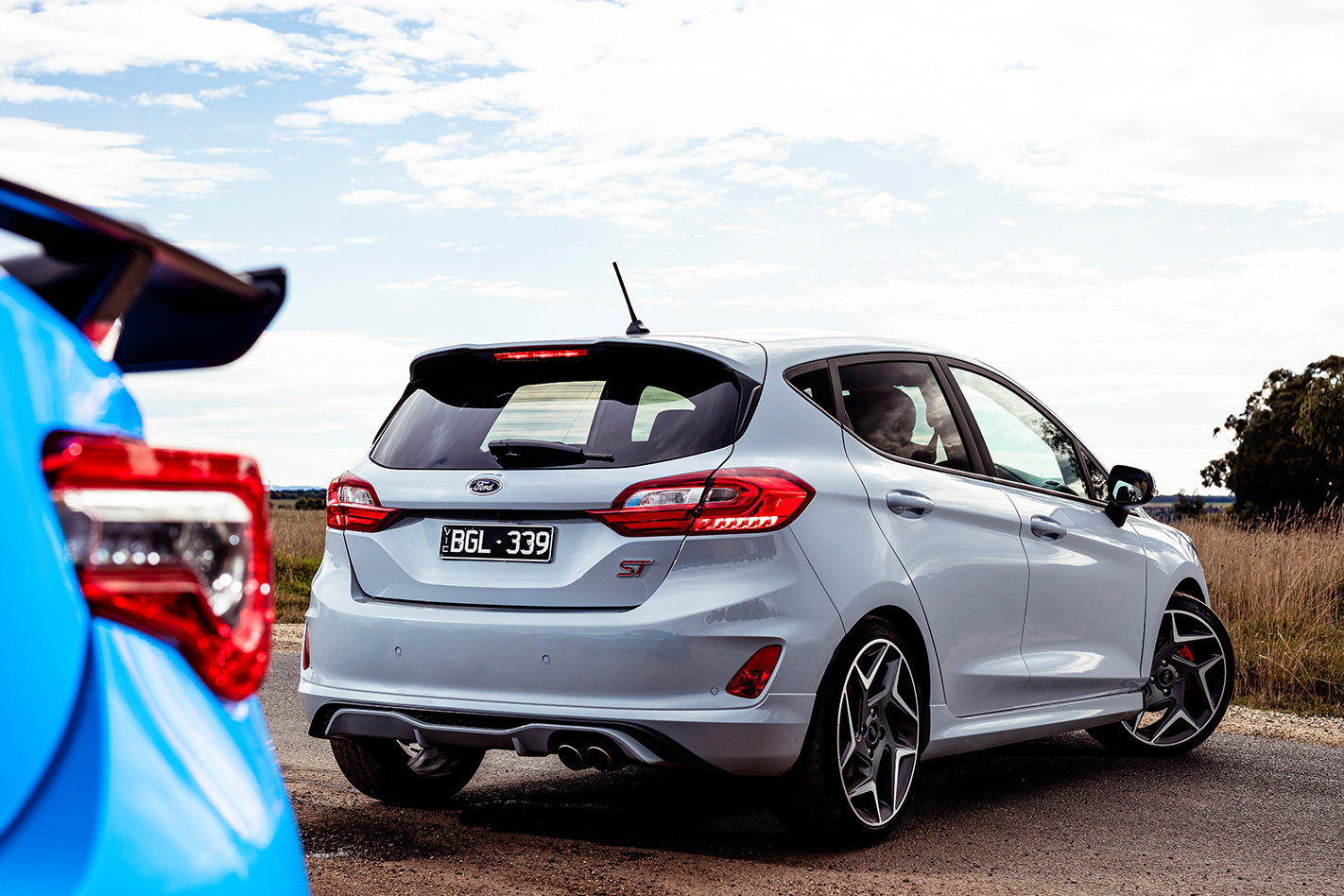
The sole 86 made available to us comes in Apollo Blue, signifying a top-of-the-range colour combination with black exterior bits. It’d be $36,640 if not for a Performance Pack that adds $2950 for an as-tested price of $39,590. That gets you special Sachs dampers with upgraded Brembo brakes, but you can also add this pack to a lower-trim 86 GT for a total of $34,340. It’s also worth bearing in mind the absolute glut of 86s on the Australian used car market, these days for as cheap as $15K.
Yet while they’re closely matched on price and concept they are vastly different under the skin. The Fiesta’s ‘puller’ layout and humble origins should dash its hopes of matching the 86’s pure rear-drive dynamics, but Ford’s Sports Technologies team worked hard to minimise any handicap starting with a five-door chassis only 93mm longer compared to the 2015 three-door version. The wheelbase is only 4mm longer, however the tracks are wider by a massive 33mm out front, 16mm rear.
New steering knuckles relocate the front-end geometry and the steering rack is supposedly the quickest in Ford’s stable. Extra body bracing increases shell stiffness 14 per cent. The ST team has also thrown the kitchen sink at its suspension. New “frequency selective” damping, patented “force vectoring” springs in the torsion-beam rear suspension and a Quaife helical LSD (included with the Performance Pack) promise it’ll make the most of Pilot Sport 4 tyres. Joining that Performance Pack is a new launch control function, designed to tame its 1.5-litre inline three-cylinder through a six-speed manual.
Thanks to some clever turbocharging, dual-injection and independent variable twin-cam timing the engine is smaller but also deadlier than ever, matching the old 1.6-litre turbo four’s outputs on overboost with 147kW and 290Nm. That would have matched the Toyota 86 kilowatt for kilowatt before 2016, but ever since engineers bolted a ported intake manifold with longer runners on top of its flat four and some larger exhaust pipes underneath, the 2.0-litre has been good for 152kW. That’s 5kW more than the ST, although interestingly both cars share the same 121kW/tonne power-to-weight ratio. We’ll see how that translates with opposing axles doing the power-down in each car, at Heathcote Raceway’s drag strip.
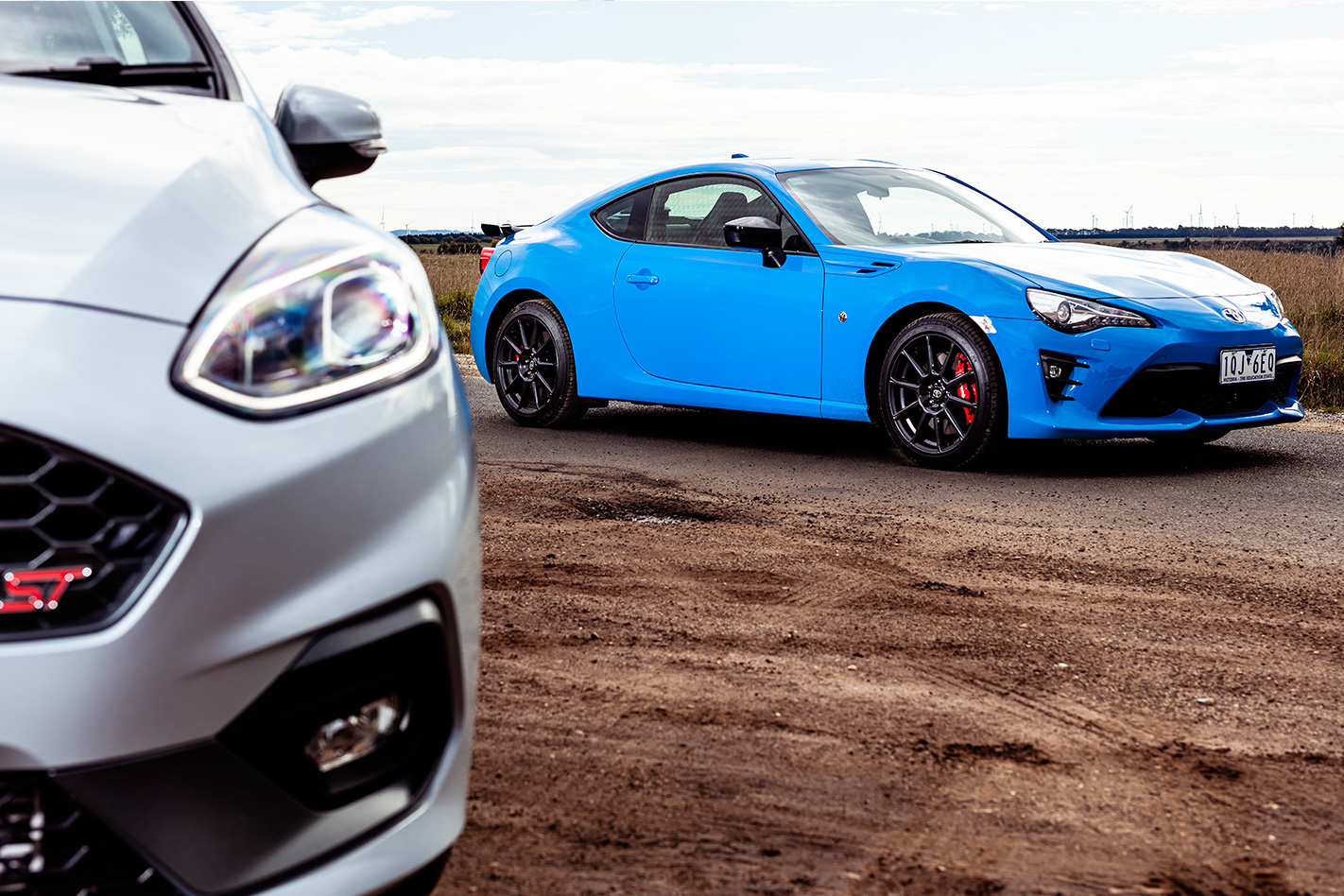
Our fact finding mission starts with the 86, although it’s obvious that Victoria’s winter has all but frozen the strip’s VHT given the 86 vaporises its 215mm-wide Primacys after stepping off the six-speed manual’s clutch with a good chunk of revs. This is with ESC ‘off’, mind you, and things don’t improve. Lowering the launch rpm highlights not only the gaping torque hole between 3000-4500rpm but the long wait for power to arrive at 7000rpm as well. Eventually we discover the concrete surface lying between each launch pad can hold a 5000rpm clutch drop. You’ll need to keep an eye on the revs to be able to both sweep through power peak and avoid clipping the 7500rpm limiter that arrives right after. Second to third doesn’t like being rushed, either, even though the 86 offers a nice, direct shift most of the time and chirps on each upshift.
In the end, our best effort logs a 7.47sec sprint to 100km/h from rest and 15.27sec run across the 400m mark at 149.53km/h. We’re slightly disappointed to fall short of times extracted from an 86 GTS at Winton in 2017 – where MOTOR nailed a 7.12sec and 15.13sec – but it’s nice to still best the manufacturer’s 0-100km/h claim by over a tenth.
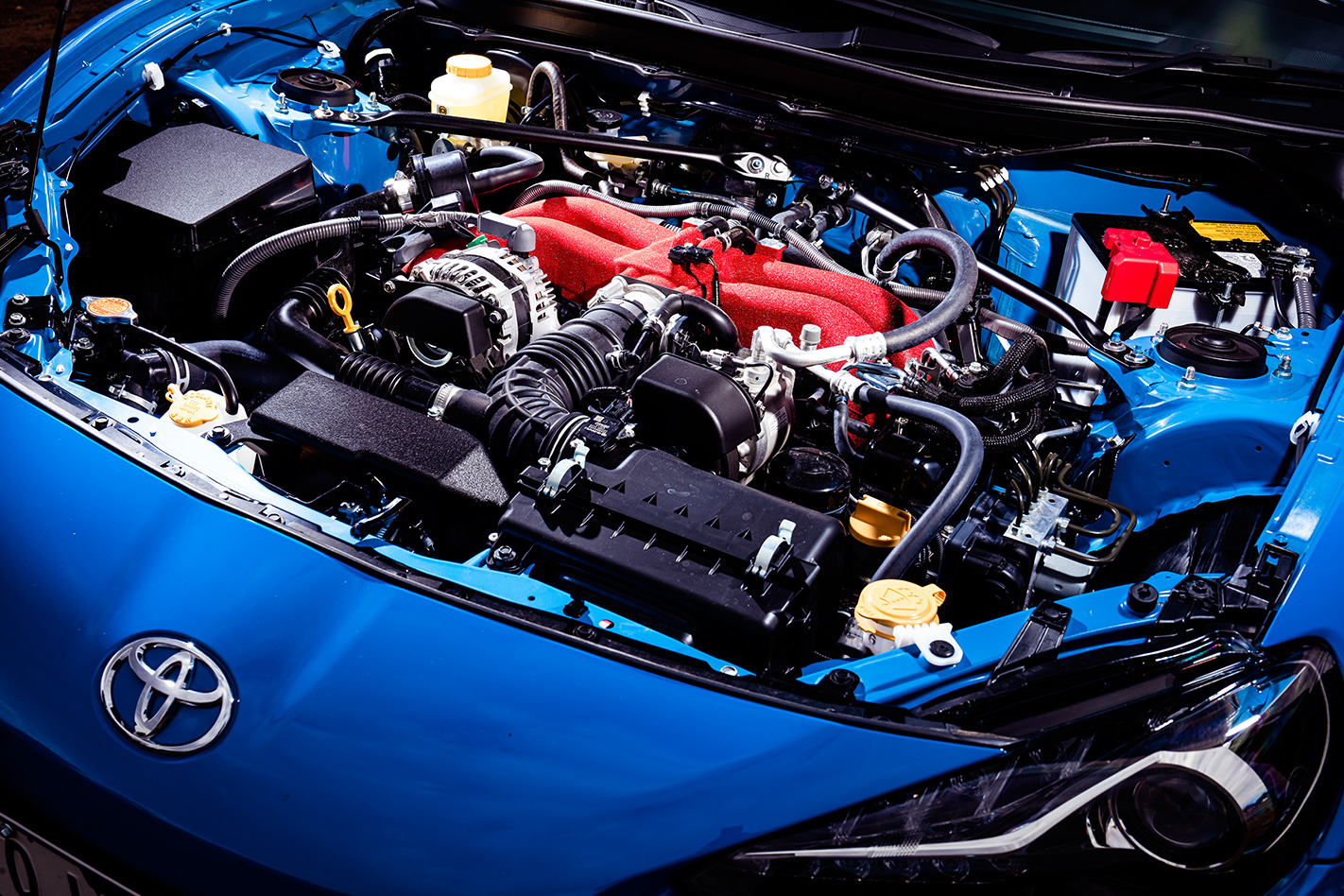
Now it’s time for the Ford. Despite its higher seating position and upright stance, sliding into the Ford’s hugging Recaro pews immediately sets the tone in the ST. This isn’t just some lowered grocery getter, it’s a serious performance car, and we’re hoping it’s going to prove it. Despite fixed suspension, the ST’s powertrain and electronics can switch between Normal, Sport and Race modes.
Fish through the central digital cluster a little longer and you’ll find the launch control program, which is activated with the right button pad on the steering wheel. The six-speed manual’s knob sits nice and close to hand. Slot first, dip the clutch and pin the throttle. The revs pulse at 3000rpm. But once we’re off, launch control seems to limit torque, even in Race mode that relaxes the ESP. So our next run we switch it off. Dial up 4000rpm and… success! Extra wheelspin throws the ST down the strip with pace. The shift action might be slightly vague, however it falls into place as if the stalk is magnetised to each gate. The engine’s eager to please and spreads its mid-range punch high enough to carry you to its 6000rpm power peak, but the shift light flashes early, warning there’s not much point in spinning beyond 6000rpm. In the end the ST clips 100km/h from rest in 6.93sec and crosses the finish line in 15.01sec at 154.58km/h.
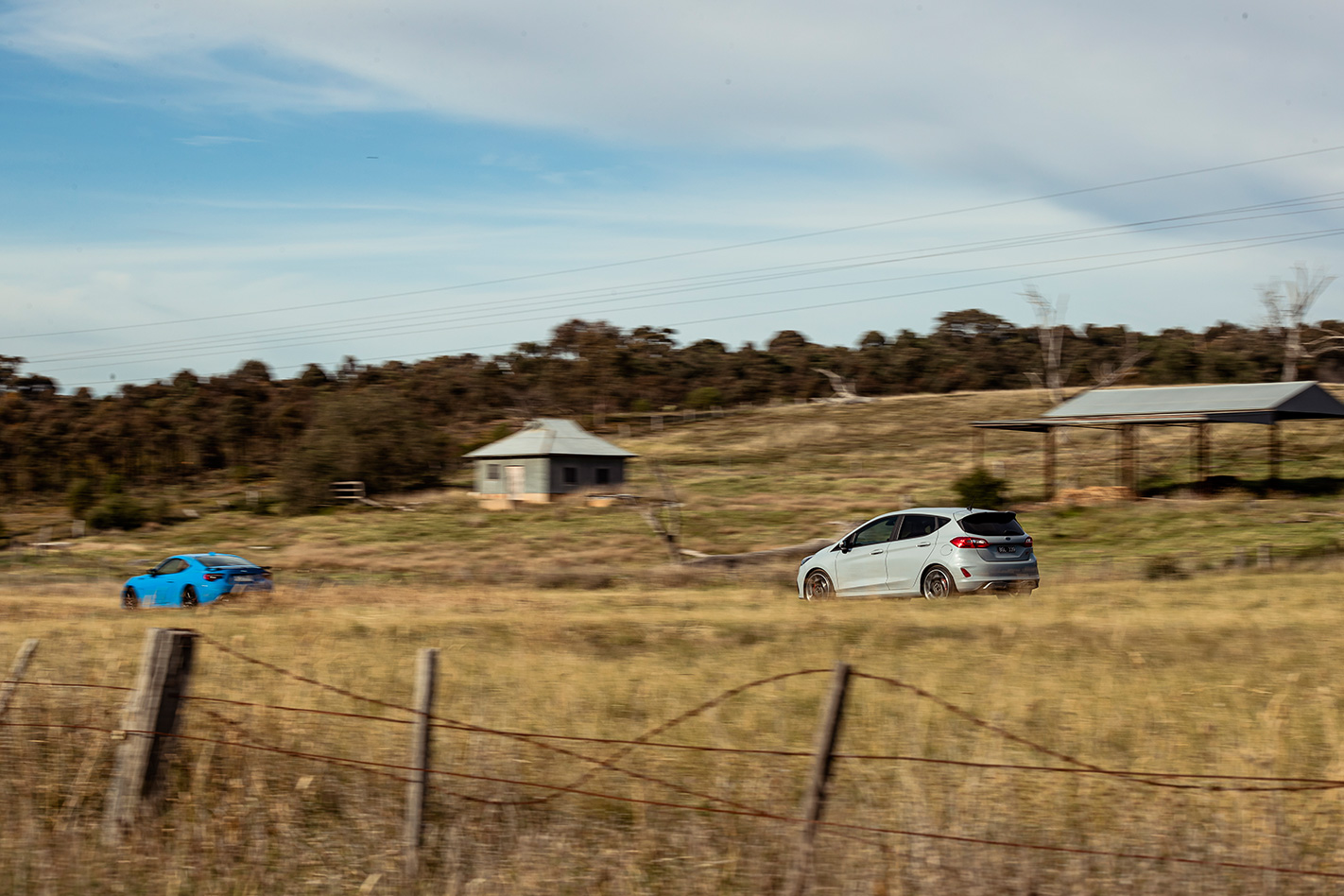
This is far off Ford’s 6.5sec 0-100km/h claim, but the figures shave 0.55sec and 0.26sec off the 86’s time, with a big difference in top speed. Despite the identical power-to-weight ratios their unique engine and drive layouts put it to use at different ends of the strip. The Toyota, for instance, launches quickest. After squatting on hard, skinny rear tyres it finds just enough grip from its Primacys to momentarily handle a violent clutch drop. So, despite a slower 0-100km/h time, it stays ahead of the Fiesta over the first 150m. The lead begins to slowly turn with each gearshift, however, when each car’s revs drop afterward. Here, the ST’s superior mid-range grunt punches it forward. And once it’s on a roll a front-wheel drive’s superior efficiency transmits more kilowatts to the road, allowing the ST finish two car lengths ahead at the finish line. With the ST landing a big hit on 86, the battleground moves on to a place our lead-tipped lightweights were made for.
Setting off along Victoria’s highways presents a quick chance to assess each car’s liveability before we find some twisting roads and from where you sit in the 86 its interior feels a generation old, even with fancier dash trim and climate control in the GTS. Get past that, however, and you’ll realise the things that matter are spot on. The legs-ahead driving position is complemented by good steering adjustability and perfect placement for the shifter, handbrake and pedals. Ergonomically it’s hard to fault and its ride is commendable. Those Sachs dampers inject the 86 with more longitudinal stability as if its wheelbase is actually 100mm longer than it really is.
The ST, meanwhile, has also improved its ride quality. It pitches gently on softer damping compression and even though it’s on stiffer spring rates than before, the wider footprint does well to absorb impacts. But while it’s a step forward in its own right, it can’t match the 86’s more evolved independent suspension. The coupe is simply more compliant and the road noise from the ST’s Pilot Sport 4 tyres is worse. These flaws fade from mind, though, once we finally arrive at some corners.
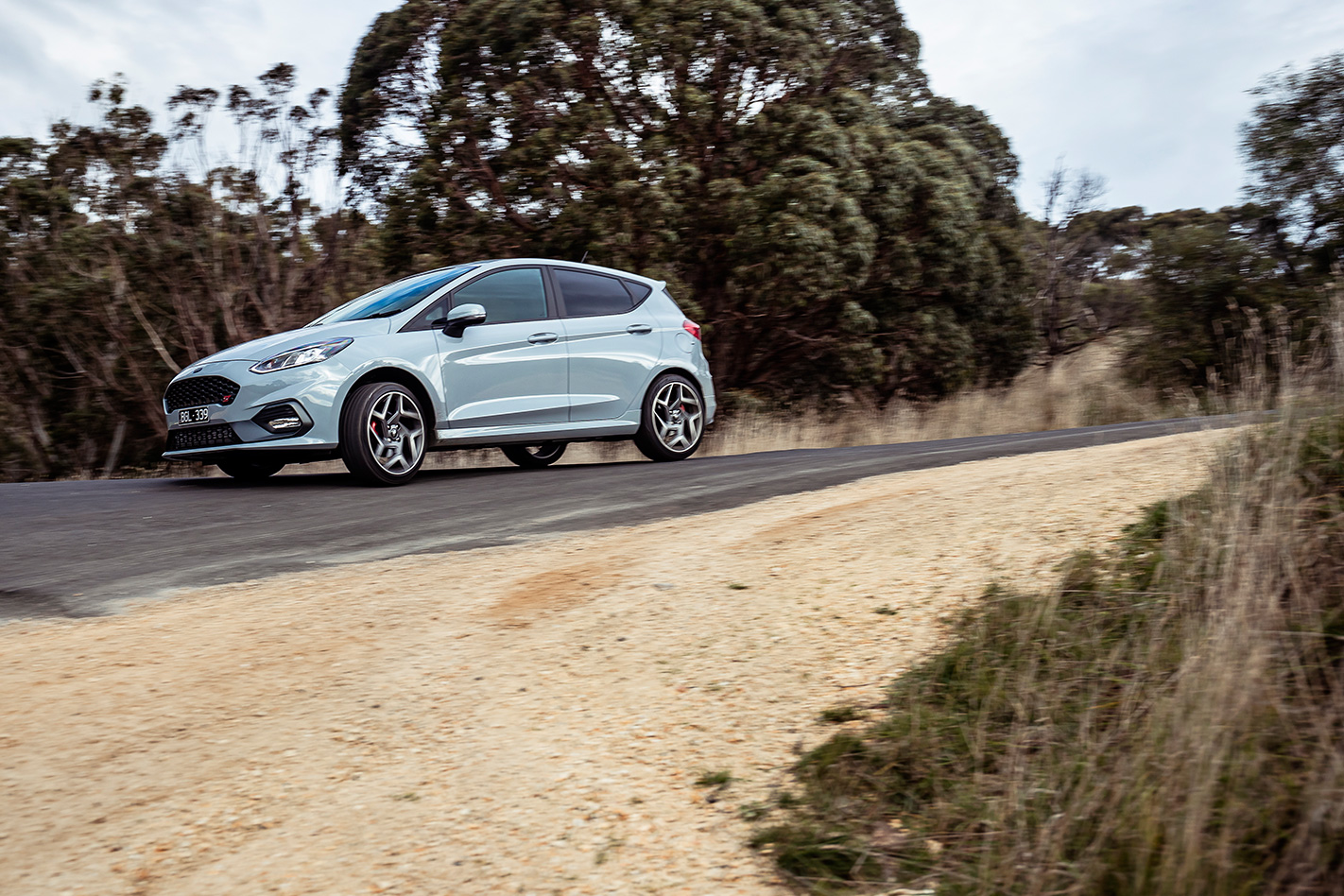
The ST has loads of grip and shows us how a front-drive car ought to use it. Pelt it at a bend, squeeze the brakes and it’ll hoist its bum in the air to point its nose at an apex. Get on the gas, feel the LSD engage, and it’ll hold your line with some assistance from the front brakes, deploying its modest grunt to pull you along. Unlike the old version’s hair raising lift-off oversteer, it’s easy to judge the rear axle’s intentions in the new ST. It cocks a leg to show you’re driving it the right way.
The 86, however, hunkers down for its approach. It still needs to move weight around to find grip, but with a centre of gravity hovering somewhere around that flat engine’s crank, it relies on coaxing its tyres, rather than rear roll stiffness, to the limit. Great brakes help. The Fiesta’s weedy 278mm front discs lag behind the 86’s big Brembos in power and feel. Breakaway is also more progressive on the 86’s low-grip Michelins than the ST on its stickier hoops, as once the ST’s tyres reach temperature it becomes increasingly harder to fling around. So while the 86 dances with a touch more flair up a mountain pass, the ST charges hard.
That three-cylinder lives to give, pumping grunt through the front axle from low in its rev range and on noise the three cylinders sound like a Ford BDA engine through a phone speaker. Synthesised engine noise is laid over the active exhaust’s note, but it’s not the only one messing with acoustics. The 86’s amplified intake noise is almost as cringe-worthy, however wringing every last rpm from a 7400rpm redline is far more involving. And while crisp throttle response does not mask its lack of grunt or linearity, on tight hill climbs its gears are more consistently spaced, helping you keep it in the right powerband.
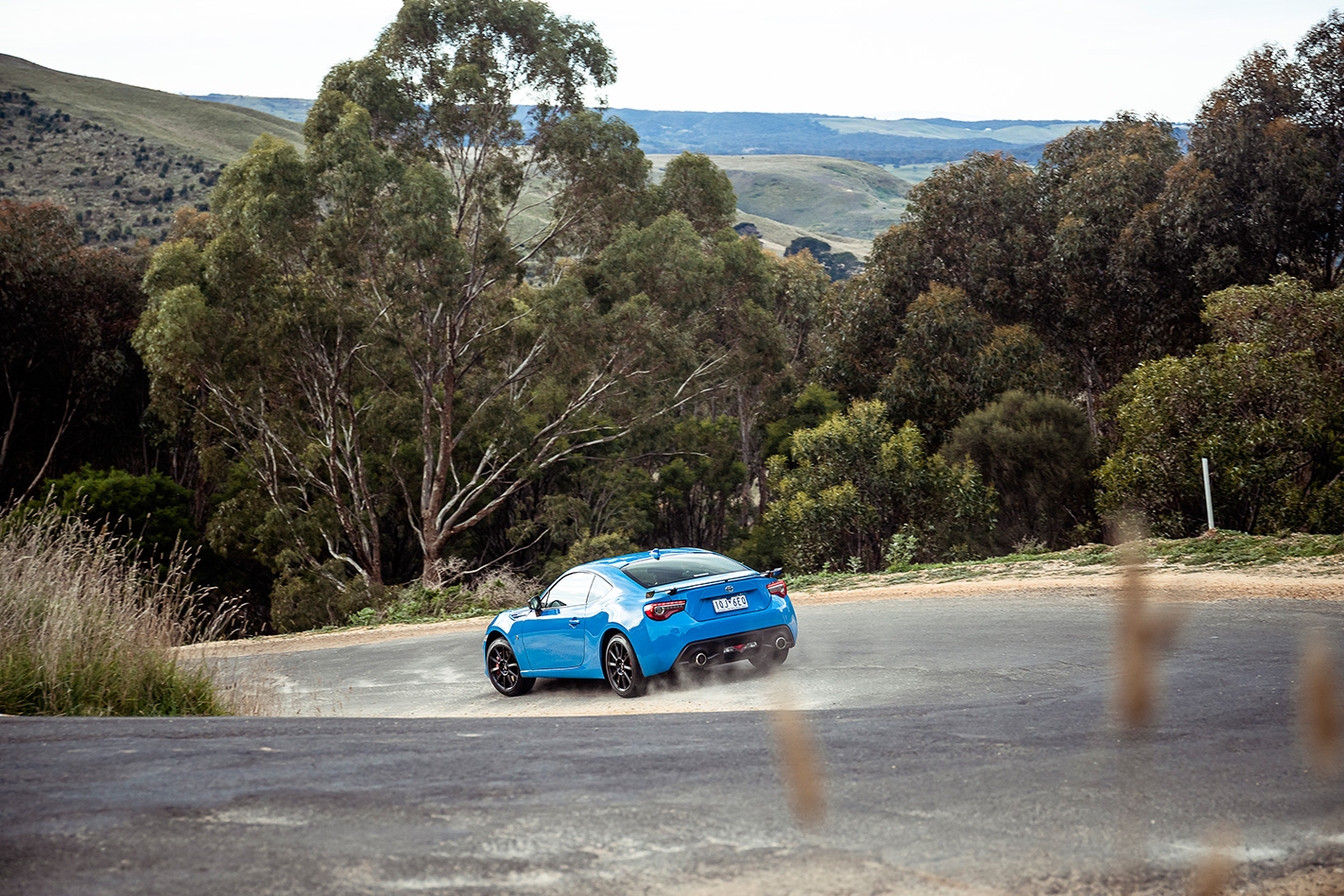
While they’ve felt closely matched until now, trading blow for blow, our next road loop delivers a knockout punch. It may as well be straight from a WRC stage. Long steady 100km/h corners with huge ruts and rippled tarmac lead into gravelly hairpins with questionable cambering. The 86 remains unfazed. Its damping reveals no compromise on high or low speed tuning and steam rolls the road with poise, insulating the car’s creamy steering from disturbance and keeping the pure connection between your hands and its front wheels intact. You can smash the brakes or pin the throttle in confidence the tyres are stuck to the surface while our ST struggles to match its stoicism.
The surface overwhelms the ST’s damping and leaves its springs to control larger 18-inch wheels. The wheels deflect often, pushing you off line when on the throttle or corrupting the ST’s sweet, light and accurate steering when you’re not. Meanwhile the higher centre of gravity encourages a wobble over mid corner bumps. Here, the 86 gives you the confidence to push it harder. But that’s what a ground-up sports car like the 86 should deliver, since its engineers would have made fewer compromises.
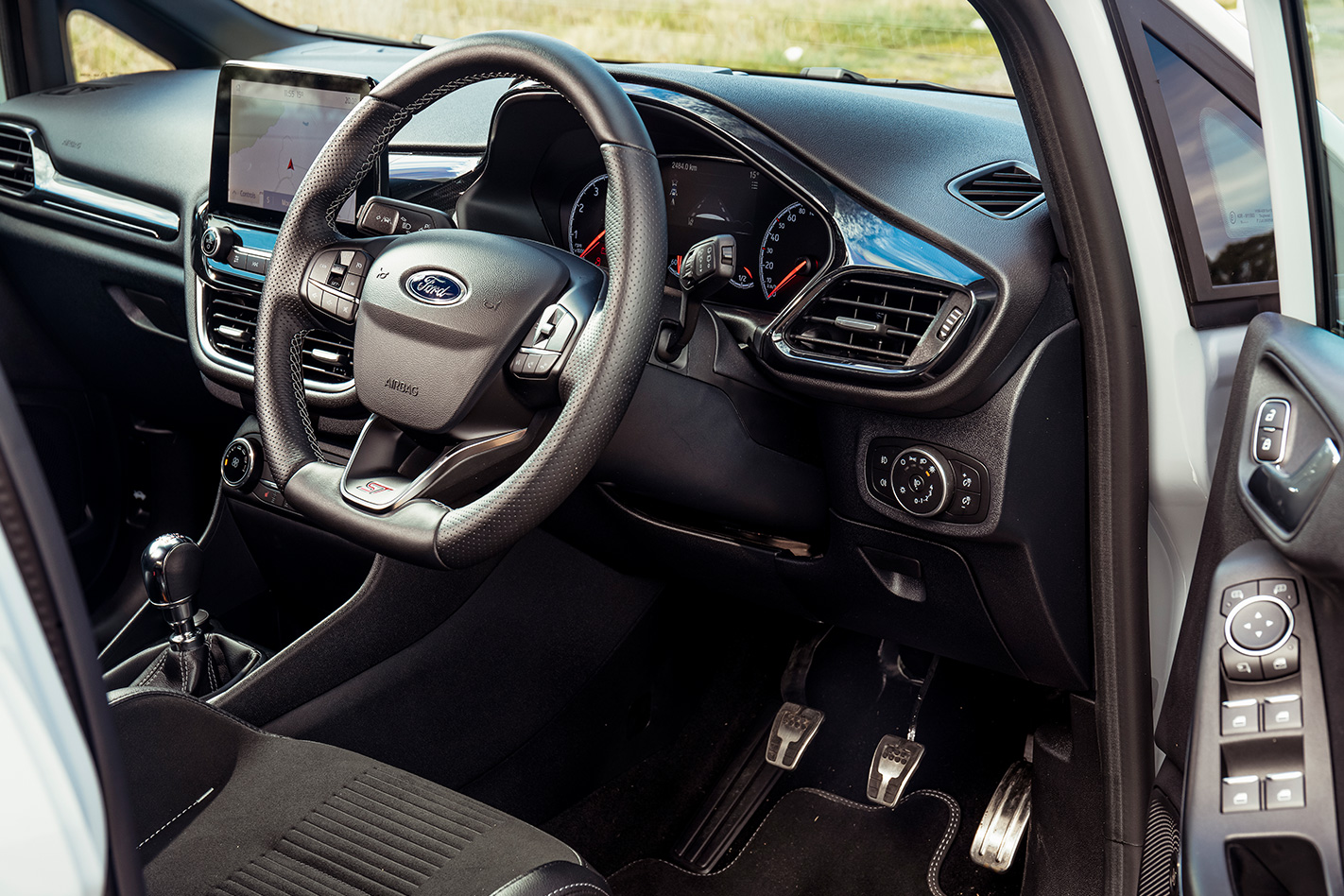
The ST does benefit from its consumer origins, boasting B&O audio, Recaro seats, more luggage space and a superior infotainment system. Those five doors will also prove a blessing if you are eyeing off either car as a daily and it’s almost better looking every angle other than front-on. It is in isolation a big jump forward for small hot hatch performance. You’re getting a lot of car for $32K. And the Fiesta ST will be keen to flex its authority as the ultimate cheap thrill if it gets a run at Bang For Your Bucks.
However an 86 GT with Sachs dampers and Brembo brakes charges only $2050 more. And while both cars are going to dial up plenty of smiles, the 86 just pips it for fun. Sure, it is not as nice inside in either GT or GTS specification, nor has the car itself changed much in eight years. And while rear-wheel drive adds another dimension to its experience the ST cannot, that’s the point here.
The 86 is a finely honed driving machine and only Toyota’s economies of scale could justify building something like this for under $40K. Its low-grip, high-slip thrills will never age. And before an all-new generation arrives in 2021 to possibly change it for better or worse, this ageing warrior remains worth celebrating.
READ NEXT:
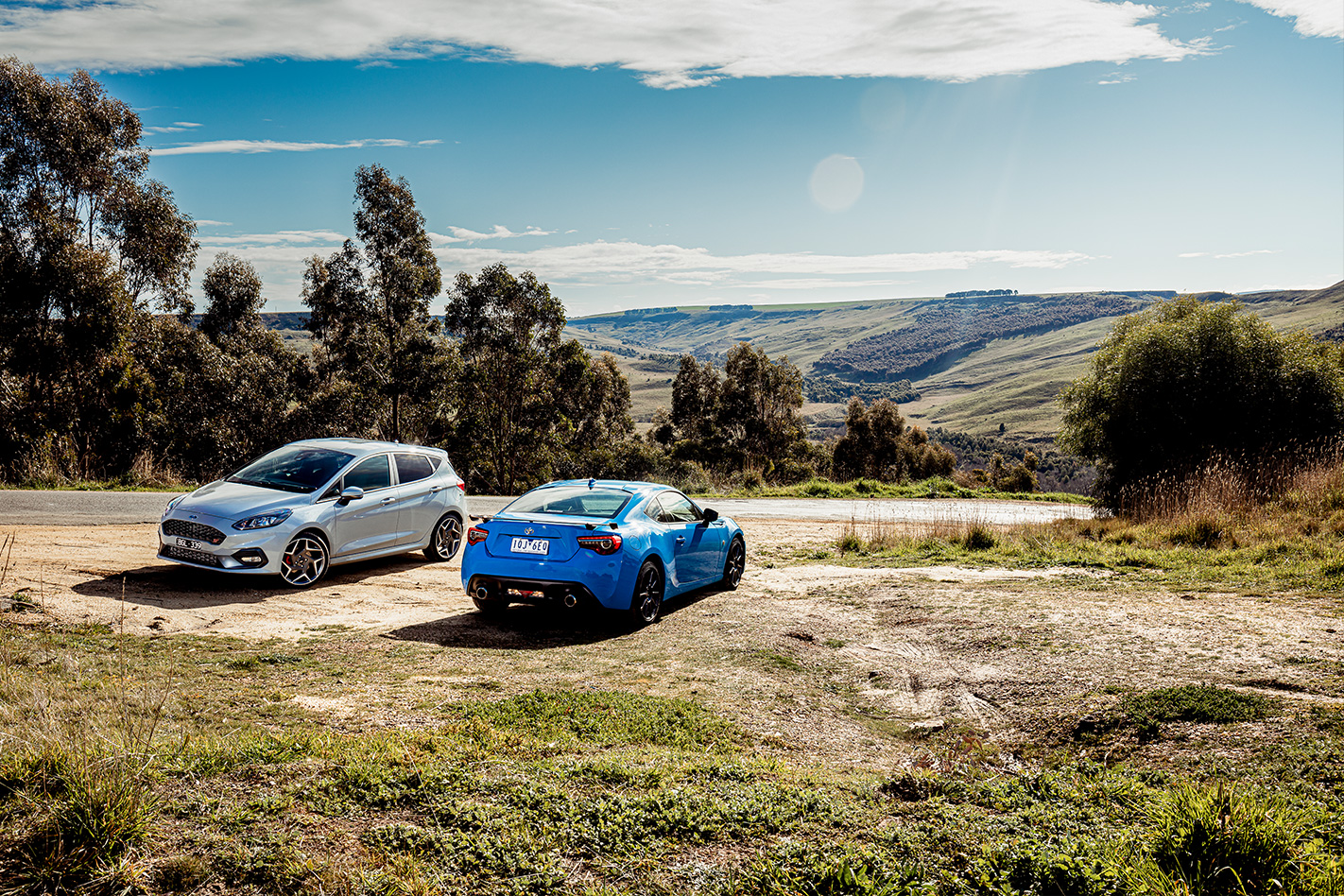
Ford Fiesta ST Technical Specs
Body: 5-door, 5-seat hatch Drive: front-wheel Engine: 1497cc inline-3, DOHC, 12v, turbo Bore/stroke: 84.0 x 90.0mm Compression: 9.7:1 Power: 147kW @ 6000rpm Torque: 290Nm @ 1600-4000rpm Weight: 1217kg Transmission: 6-speed manual kw-per-tonne: 121kW/tonne Suspension: struts, coil springs, anti-roll bar (f); torsion beam, coil springs (r) L/W/H: 4068/1735/1469mm Wheelbase: 2493mm Tracks: 1506/1476mm (f/r) Steering: electrically assisted rack-and-pinion Brakes: 278mm ventilated discs, single-piston calipers (f); 253mm solid discs, single-piston calipers (r) Wheels: 18.0 x 7.5-inch (f/r) Tyres: 205/40 ZR18 (f/r); Michelin Pilot Sport 4
Rating: 4.5/5 Price as-tested: $32,940 PROS: Three-wheels like a hero; grunty three cylinder; seriously frugal; nice interior CONS: Not as compliant or involving; it’s not rear-wheel drive
Toyota 86 GTS Performance Pack technical specs
Body: 2-door, 4-seat coupe Drive: rear-wheel Engine: 1998cc boxer-4, DOHC, 16v Bore/stroke: 86.0 x 86.0mm Compression: 12.5:1 Power: 152kW @ 7000rpm Torque: 212Nm @ 6400-6800rpm Weight: 1258kg Transmission: 6-speed manual kw-per-tonne: 121kW/tonne Suspension: struts, coil springs, anti-roll bar (f); A-arms, coil springs, anti-roll bar (r) L/W/H: 4240/1775/1320mm Wheelbase: 2570mm Tracks: 1520/1540mm (f/r) Steering: electrically-assisted rack-and-pinion Brakes: 326mm ventilated discs, 4-piston calipers; 316mm ventilated discs, 2-piston calipers Wheels: 17.0 x 8.0-inch (f/r) Tyres: 215/45 R17 87W (f/r); Michelin Primacy HP
Rating: 4.5/5 Price as-tested: $39,590 PROS: Enchanting chassis, steering and brakes; revvy top-end; direct shift CONS: Hardly a looker; torque hole; dated looking interior


